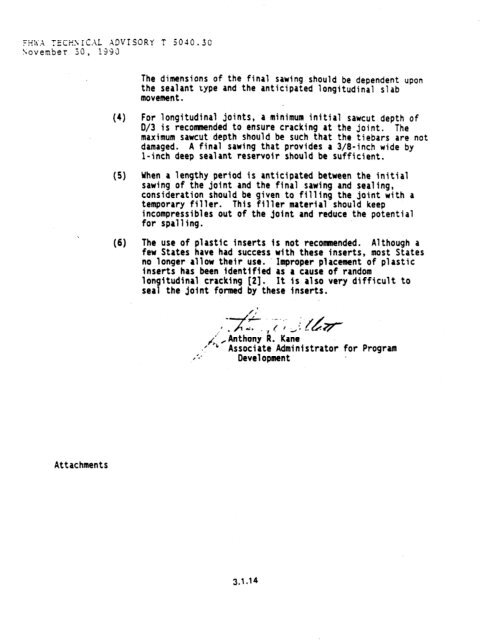chapter 3 rigid pavement - DOT On-Line Publications - Department ...
chapter 3 rigid pavement - DOT On-Line Publications - Department ...
chapter 3 rigid pavement - DOT On-Line Publications - Department ...
Create successful ePaper yourself
Turn your PDF publications into a flip-book with our unique Google optimized e-Paper software.
CH!\‘.?l TECZSIC'.AL ADVISORY T 5040.30<br />
November 30, 1333<br />
Attachments<br />
(4)<br />
(5)<br />
(6)<br />
The dimensions of the final sawing should be dependent upon<br />
the sealant type and the anticipated longitudinal slab<br />
movement.<br />
For longitudinal joints, a minimum initial sawcut depth of<br />
O/3 is reconmtended to ensure cracking at the joint. The<br />
maximum sawcut depth should be such that the tiebars are not<br />
damaged. A final sawing that provides a 3/8-inch wide by<br />
l-inch deep sealant reservoir should be sufficient.<br />
When a lengthy period is anticipated between the initial<br />
sawing of the joint and the final sawing and sealing,<br />
consideration should be given to filling the joint with a<br />
temporary filler. This filler material should keep<br />
incompressibles out of the joint and reduce the potential<br />
for spalling.<br />
The use of plastic inserts is not reconmtended. Although a<br />
few States have had success with these inserts, most States<br />
no longer allow their use. Improper placement of plastic<br />
inserts has been Identified as a cause of random<br />
longitudinal cracking [2]. It is also very difficult to<br />
seal the joint formed by these inserts.<br />
-<br />
/,<br />
+ .-.;.<br />
7'. c/j:.- : 44.a.a<br />
,,/~An~h~n~ 6. Kane<br />
. .<br />
, /.*<br />
Associate Administrator<br />
Development<br />
for Program<br />
3.1.14
















